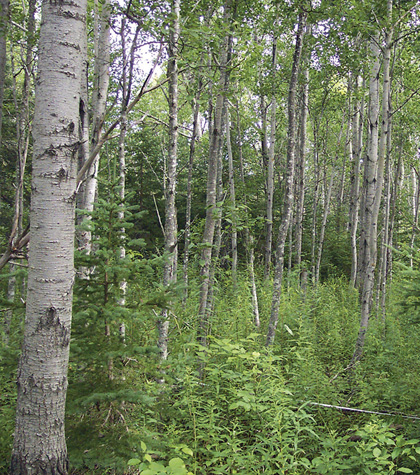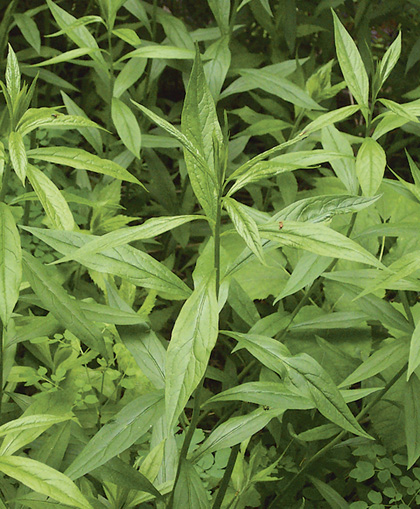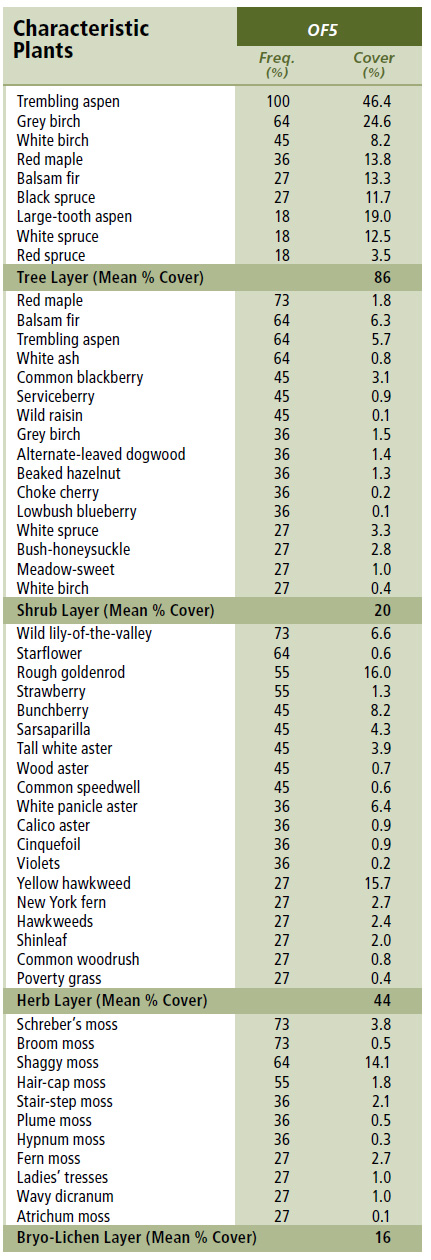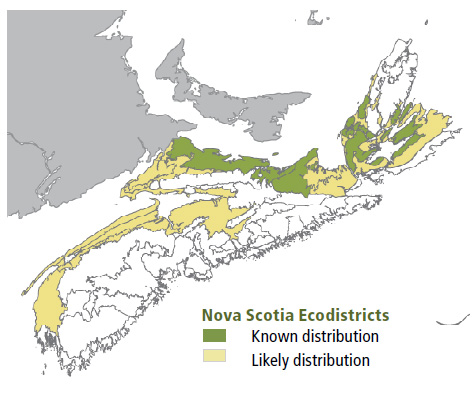
Forest Vegetation types - OF5
OF5 — Trembling aspen – Grey birch / Rough goldenrod – Strawberry
Populus tremuloides – Betula populifolia / Solidago rugosa – Fragaria virginiana
 |
Telford, Pictou County |
Concept: This early successional Vegetation Type (VT) has an overstory dominated by trembling aspen and grey birch, with a variety of other associates found with lower canopy abundance. This VT is associated with a range of moisture conditions, but is more common on wetter sites and previously cleared riparian forests. Shrub and herb layers are usually better developed than on other old field sites. OF5 is found scattered throughout the province, but is less common than other first generation old field types (OF1, OF2, OF3).
Vegetation: Trembling aspen and grey birch are the dominant overstory trees, with lesser white birch, red maple, balsam fir and/or black spruce. The well-developed shrub layer includes serviceberry, blackberry, wild raisin, beaked hazelnut and bush-honeysuckle accompanied by regenerating trees. Herb layer species are mainly those indicative of past agricultural land use, including strawberry, hawkweeds, goldenrods, asters, common speedwell, buttercups and several grasses and sedges. Leaf litter often dominates the forest floor, thereby limiting bryophyte development (although species richness may be high). Only shaggy moss is occasionally abundant, while sphagnum species can be found on wetter microsites in the stand.
Environmental Setting: OF5 is mainly associated with fresh-moist to moist-wet, nutrient medium to rich soils of fine to medium texture. This VT can be found province-wide, but is most common in lowland ecoregions (Valley and Central Lowlands, Northumberland / Bras d'Or Lowlands). OF5 sites that have been tilled or pastured will also have level microtopography and a distinct Ap (plough layer) soil horizon. This horizon may also be enhanced by active worm activity on these hardwood-dominated sites.
Successional Dynamics: OF5 is an even-aged, early successional VT dominated by trembling aspen and grey birch. Both species are shade-intolerant and have a short lifespan – factors which will eventually lead to the collapse of this ecosystem. Natural disturbance agents include insects and disease (e.g. tent caterpillar, tussock moth, hypoxylon canker) and windthrow. Subsequent successional stages will begin to include species from the original forest cover, especially if suitable seed sources are nearby. Stands that slowly deteriorate are more likely to transition to such forest conditions as shade-tolerant species regenerate on site. Clearcut harvesting may lead to re-establishment of aspen and grey birch along with other pioneer tree species (e.g. pin cherry, white birch, red maple). Depending in part on the level of advanced regeneration at the time of harvest, OF5 may also succeed to OF4 (Balsam fir –White spruce / Evergreen wood fern – Wood aster). Possible late successional stages include TH1 (Sugar maple / Hay-scented fern), TH2 (Sugar maple / New York fern – Northern beech fern), MW1 (Red spruce – Yellow birch / Evergreen wood fern) and MW3 (Hemlock – Yellow birch / Evergreen wood fern).
Ecological Features: Past cultivation across this patch forest has leveled most pre-disturbance microtopography, while rock walls and piles, old foundations and wells provide additional evidence of agricultural land use. Linear rock piles may provide dwellings for rodents, snakes, and insects like wasps and bees. Other unique aspects include the forest's close proximity to open fields, active farms, and streams and the frequent presence of apple and other fruit trees. These features may attract deer, red fox, coyote, snowshoe hare, red squirrels, beaver and game birds. Older aspen trees may provide soft snags and cavities for several species of birds, including the pileated woodpecker. Resin from aspen buds is the primary source of bee propolis, an essential hive material.
 |
| Asters spp. |
Distinguishing Features: A forest, dominated by trembling aspen with a lesser, but significant, component of grey and sometimes white birch, on abandoned agricultural lands. Asters and goldenrods are typical. Evidence of old field includes rock foundations, rock piles, rock walls and wire fencing. Sites typically have level microtopography and a soil profile that shows a plough layer.
| Slope Position: | Level6 Upper2 Middle1 Toe1 |
Surface Stoniness: |
(Non - Slightly)10 |
Bedrock Outcrop: |
(Non-rocky)10 |
Elevation Range: |
4 - 130m |
Slope Gradient: |
Gentle5 Level5 |
Aspect: |
North1 South3 West2 None4 |
Exposure: |
Moderate9 Mod. exposed1 |
Microtopography: |
Level6 Slightly2 Moderate1 Severely1 |
Drainage: |
Imperfect4 Moderately well3 Poor2 Well1 |
Soil Type: |
ST72 ST82 ST122 ST2-L1 ST31 ST91 ST111 |
Parent Material: |
Glacial till8 Alluvium1 Colluvium1 |
Rooting Depth (cm): |
(<30)1 (30-45)5 (>45)4 |
Duff Thickness (cm): |
(0-5)6 (6-10)1 (11-20)1 nd2 |

